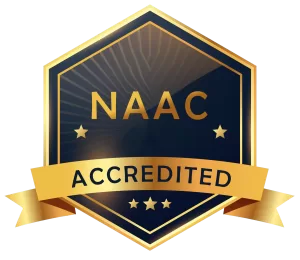Santhosh Rahul K, Joy Aleesha, Mathew Josey, George Liza, Paul Sinju, Yacob Jeason Paul
Department of Dept. of Conservative dentistry & Endodontics, Annoor dental college & hospital, Muvattupuzha
Running title – PPE knowledge before and after Covid 19 pandemic
Received: 01-03-2023
Revised: 06-03-2023
Accepted: 08-03-2023
Address for correspondence: Dr. Aleesha Joy, Assistant professor, Dept. of Conservative dentistry & Endodontics, Annoor dental college & hospital, Muvattupuzha, Kerala
E-mail: aleeshajoy.1991@gmail.com
This is an open access journal, and articles are distributed under the terms of the Creative Commons Attribution-Noncommercial ShareAlike 4.0 license, which allows others to remix, tweak, and build upon the work non-commercially, as long as appropriate credit is given and the new creations are licensed under the identical terms
How to cite this article: Santhosh R K, Joy A, Mathew J, George L, Paul S, Yacob J P. Knowledge and awareness of use of personal protective equipments among dental practitoners before and during covid-19 pandemic J Oral Biomed Sci 2023; 2 (1): 10-15
INTRODUCTION
COVID-19 is a recent viral outbreak across the world. It causes an emerging respiratory disease by the new member of the coronavirus (SARS-CoV 2) – novel coronavirus. It was first reported on December 2019 in Wuhan city of China. The virus spread quickly throughout the world. The first case of COVID-19 in India was reported in January 27,2020 in Kerala1.
SARS-CoV 2 virus may infect both mammals and birds. The virus primarily infects human lung cell through a receptor for an enzyme – Angiotensin Converting Enzyme2(ACE2). The virus, once introduced into the lung cells, releases viral RNA into the cytoplasm, produce new viral particle propagating the infection2.
The common transmission routes of COVID-19 include direct transmission respiratory droplet, saliva, direct contact, and other body fluids and indirect contact through fomites, infected instruments and faecal-oral route. During dental practice there are many ways of transmission of the infection through dental instrumentation, saliva and respiratory source. The viral particle is seen within the fluids in the mouth. A significant source of these species is seen in the dental plaque, periodontal pocket etc, similarly, the nasopharynx act as a reservoir of viral particle2.
According to the reports dental practitioners are most prone to this disease as they are transmitted through inhalation/droplets/ingestion/salivary droplets, respiratory fluid and aerosols. They may survive on surfaces, object that are exposed to the infected body fluids. The viral load in saliva is very high and serve as a potential source of infection. Dental office seems to have high risk of nosocomial infection and dental practitioner are considered to be at high risk1 because of close contact with the patient. In addition, the aerosols generating procedures cause emission of airborne droplets from the patient’s mouth into the surrounding environment, which is one of the main routes of transmission of COVID-192. The aerosols in a COVID-19 positive patient will likely contain a high viral load thereby increasing the risk of transmission to the dental staff during a treatment. Because of this the dental practitioners were forced to restrict their practice during the pandemic.
WHO declared PPE (Personal Protective Equipment) mandatory for all health workers including dentists. Masks, head caps, gowns, headcovers and eye safety goggles or face shields are different kinds of PPE used to reduce the transmission rate. Occupational Safety and Health Administration department has classified the occupational risk on the exposure to these viruses. According to them dental healthcare providers were classified as ‘very high risk’. To minimise the risk of virus transmission in dental clinics, the proper advised protocol for donning and disposing of PPE should be followed. Asymptomatic COVID-19 carriers also pose a high risk3, making PPE mandatory for treating all patients including asymptomatic.
The new protocols have succeeded in decreasing the risk of transmission in the dental practice. However, their use comes at greatly increased financial cost and increased anxiety among dental practitioners. There are reports of physical difficulties associated with wearing enhanced PPE3. Also, there is the time loss due during each procedure as it requires extra time for donning and doffing. A decreased number of patient appointment in the dental office and increase in cost of PPE equipment’s has led to increase in the cost of the dental treatment.
The pandemic made the dentist to adjust to the new changes to deal with COVID-19 outbreak. With increasing awareness regarding emerging viral diseases dental practitioners have made positive changes regrading personal protection.
This study tries to find out if these positive changes are still being followed in dental practice after the pandemic has started receding.
AIM
During the covid-19 pandemic the dentist has to adjust to the new changes to deal with COVID-19 outbreak. Such sudden changes and introduction of new methods has added on to the routine practice. The use PPE become mandatory in dental field. Thus, the aim of this study is to evaluate knowledge and awareness on use of personal protection equipment’s among dental practitioners before and during covid-19 pandemic.
MATERIAL AND METHODS
Ethical Clearance and Informed Consent:
Ethical clearance from the Institutional Ethics Committee of Annoor Dental College was obtained prior to the start of the study. Informed consent was obtained from the subjects for their willingness to participate in the study.
Study Population and Study Sample:
A cross-sectional study was conducted using an online survey. All dental practitioners of Kerala who are dealing with patient before and during the pandemic are included.
A total of 245 dental practitioners were selected for the study. The sample size was calculated by n = Z²1-(α / 2) × S2 / d2
where:
Z – is the standard normal score with 95%
confidence interval (CI) (a=0.05);
S – is the standard deviation of the variable;
d – is maximum acceptable error.
A structured questionnaire in English language was made specifically for the study. The questionnaire was pre-tested for validity and reliability. Questionnaire was validated by 4 subject experts. Questionnaire included questions about the personal protection equipment’s the practitioners were using before and during Covid -19 and the differences they experienced. Questions regarding PPEs which the practitioners intend to continue using after the pandemic also were included. E-consent was obtained prior to the survey.
STATISTICAL ANALYSIS
Data was entered into a spreadsheet using Excel version 16.37. The data which was collected was analysed using Statistical Package for Social sciences (SPSS) software. The data were subjected to descriptive analysis with the help of frequencies, percentages, means.
RESULT
The sample consisted of 245 dental practitioners of age between 25 and above, female participants 135 (55.1%) and 110 (44.9%) male participants.
Majority of participants are graduates (BDS) 145 (59.2%) and 100 (40.8%) post graduates. The participants were post-graduates from different branches of dentistry: Conservative dentistry 36 (14.7%), 18 (7.3%) each Prosthodontics and Pedodontics, 16 (6.5%) Orthodontics, 15 (6.1%) Periodontics, 14 (5.7%) Oral surgery, 11 (4.5%) Oral pathology, 7 (2.9%) each from public health dentistry and oral medicine and radiology.
The participants are currently working in the following sectors: 75 (30.6%) private colleges, 57 (23.3%) are on private practice, 43 (17.6%) are working in private hospitals, 30 (12.2%) are on private consultation, 17 (6.9%) of the participants are from government hospitals, 16 (6.5%) of participants from government college and 7 (2.9%) are by other means.
148 (60.4%) of the participants has an experience of < 5 years, 67 (27.3%) has an experience of 5 – 10 years and 30 (12.2%) of participants of more than 10 years.
Questions were also based on the hours spend in clinics on a daily basis. Majority 146 (59.6%) spend 5-8 hrs in their clinics, 70 (28.6%) spend more than 8 hrs in clinics and 29 (11.8%) spend less than 5hrs in clinics. Table 1 shows the Sociodemographic characteristics of the participants.
Table 1: Sociodemographic characteristics of the participants
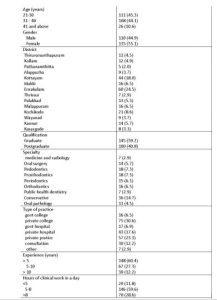
When assessed on the use of protective equipment’s before and post covid-19, Before COVID-19 it is found that most of the clinicians were using surgical masks 125 (51.0%) and during the pandemic there is a large decrease in use of surgical mask 56 (22.9%). Surgical masks replaced with N95 masks. The result showed that there is a massive increase in use of N95 mask during the pandemic 146 (59.6%) than before the pandemic where it was 12 (4.9%), as N95 masks were mandatory during the pandemic. Table 2 shows type of masks used before and during covid
Table 2: Type of masks used before and during covid
| Before Covid | During Covid | |
| Type of mask
a. Single layer b. Double layer c. Surgical d. N95 e. Any other |
59 (24.1) 48 (19.6) 125 (51.0) 12 (4.9) 1 (0.4) |
7 (2.9) 33 (13.5) 56 (22.9) 146 (59.6) 3 (1.2) |
Table 3 shows type of gloves used before and during covid
On evaluation of results of type of gloves, the dentists were using during this period shows most of the clinicians were using examination gloves before the pandemic 162 (66.1%) and surgical gloves was only 78 (31.8%) whereas during the pandemic most of dentists were using surgical gloves 107 (43.7%). The results also showed there is increase in usage of double gloves during the pandemic from 5 (2.0%) to 51 (20.8%).
Table 3: Type of gloves used before and during covid
| Before Covid | During Covid | |
| Type of gloves
a. Examination gloves b. Surgical gloves c. Double gloves |
162 (66.1) 78 (31.8) 5 (2.0) |
87 (35.5) 107 (43.7) 51 (20.8) |
Table 4 shows type of PPE used before and during covid
The usage of personal protective equipment before and during COVID-19 showed that there is massive increase in the usage of PPE kit among the practitioners 146 (59.6%) from 11 (4.5%) before COVID. Also, there is large increase in usage of face shields which was found to be 207 (84.5%). The results indicate that there is an increase in the knowledge and usage of personal protective equipment among the dental practitioners during the COVID pandemic. Table 4 shows the type of protective wear used before and during covid.
Some of the participants (21.2%) felt that they were more professional, whereas 11.8% felt both confident and professional while using PPE
Table 4: Type of PPE used before and during covid
| Before Covid | During Covid | |
| Personal protective equipment’s
a. Head cap b. Face shield c. Protective eyewear d. PPE kit |
187 (76.3) 67 (27.3) 94 (38.4) 11 (4.5) |
194 (79.2) 207 (84.5) 121 (49.4) 146 (59.6) |
Figure 1 – 66.5% of participants still follow the recommended precautions before starting the treatment procedures.
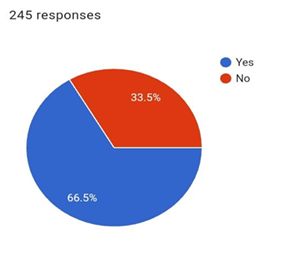
Figure 2: Use of PPE after COVID showing that 77.1% participants are planning to continue the use of PPE after COVID
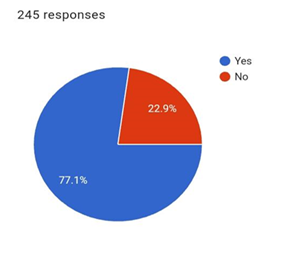
Figure 3 shows that 92.7% participants recommend PPE to be used in clinical practice
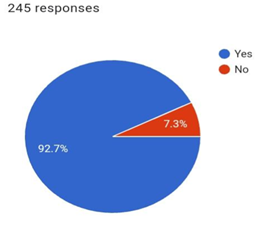
DISCUSSION
The use of personal protective equipment is much more relevant in the current scenario and its importance was emphasized worldwide due to the covid-19 pandemic. The present study throws light into the awareness of dental practitioners on the use of personal protective equipment. Use of masks(N95), gloves, gowns, protective eye wear, face shield protect the skin and eyes from the viral particles.
The appropriate use may reduce the transmission of the virus. The current study evaluated the knowledge and awareness on the use of personal protective equipment’s among the dental practitioner before and during COVID-19 pandemic. The study also aimed to access the practice of PPE during COVID 19 and attitude of dentist regarding working difficulty and its cost.
The study is conducted with 245 dental practitioners of Kerala. Both graduate and post-graduates are selected for the survey. The google form sent to each participant and their response are gathered and are tabulated. On evaluation of results of the study indicates there is an overall increase in the usage of personal protective equipment’s among the practitioners.
On analysis, the practice of use of PPE has changed since COVID 19, which varies between increased a bit to increase a lot. On analysis of the given responses, it was found that there is a marked increase in the usage of N95 mask among the dental practitioners which was not seen before COVID, as N95 masks have become mandatory during the pandemic. From the results, female practitioners show more interest on wearing N95 masks than males.
There is only a moderate difference in the change in the type of gloves used before and during covid. This may be due to the reason that the dental practitioners were using gloves for routine dental procedures before pandemic also.
The usage of PPE kit was about 10 folds during the pandemic. Majority of the practitioners reported an increased treatment cost due to the use of PPE. PPE prises has become significantly higher during pandemic compared to pre pandemic. The analysis show that the post graduate has greater practices about PPE. This is similar to that of the results of the previous studies reported.4 This could be due to the reason that subjects engaged in academic teaching are exposed to more learning experiences which can lead to regular knowledge updating. Also, dentist practising in private dental college has more positive attitude towards PPE.
According to the results obtained from the current study, only 66.5% practitioners still follow the recommended precautions before starting the treatment procedures. Also 22.9% practitioners are not planning to continue the use of PPE in future. This information points to the fact that there is a strong need of implementation of continued educational programmes among the dental practitioners of Kerala so as to protect themselves and the patients from cross infections. The promising part is that 92.7% participants advise that PPE to be used in routine clinical practice.
Overall, there is an increase in use of personal protective equipment’s among the dental practitioners of Kerala and have a professional behaviour towards treating the patient.
CONCLUSION
Within the limitations of this study, it was found that the majority of dental practitioners had adequate knowledge regarding the use of personal protective equipment and hygiene practices. Even then the percentage of respondents with inadequate knowledge and practice requires attention and adequate measures should be taken to improve their awareness on use of PPE and hygiene practices.
There is a strong need to implement periodic educational interventions and training programs on infection control practices for COVID-19 and other emerging diseases among dentists in particular. The information from this survey helps us to make necessary changes in implementing periodic educational webinars on areas where necessary, which is important for the dental fraternity for protecting themselves and shielding our society from COVID-19.
Further studies should be carried out using large random samples before generalising this conclusion.
Conflict of interest: None
Source of support: Nil
REFERENCES
1.Poursadeqiyan M, Bazrafshan E, Arefi MF. Review of environmental challenges and pandemic crisis of Covid-19. J Educ Health Promot 2020; 9:250.
- Ali S, Zeb U, Khan M, Muhammad A. Transmission routes and infection control of novel coronavirus-2019 in dental clinics – A review. J Islamabad Med Dent Coll 2020; 9:65-72.
- Khanagar SB, Al-Ehaideb A, Naik S, Vishwananthaiah S, Maganur P, Marwah N. Primordial-level preventive measures for dental care providers against life-threatening Corona Virus Disease (COVID-19). Int J Clin Pediatr Dent 2020; 13:176-9.
- Khader Y, Al Nsour M, Al-Batayneh OB, Saadeh R, Bashier H, Alfaqih M, et al. Dentists’ awareness, perception, and attitude regarding COVID-19 and infection control: Cross-sectional study among Jordanian dentists. JMIR Public Health Surveill 2020; 6:18798.
- Patil S, Moafa IH, Bhandi S, Jafer MA, Khan SS, Khan S, et al. Dental care and personal protective measures for dentists and non-dental health care workers. Dis Mon 2020; 66:101056.
- Ge ZY, Yang LM, Xia JJ, Fu XH, Zhang YZ. Possible aerosol transmission of COVID-19 and special precautions in dentistry. J Zhejiang Univ Sci B 2020; 21:361-8

